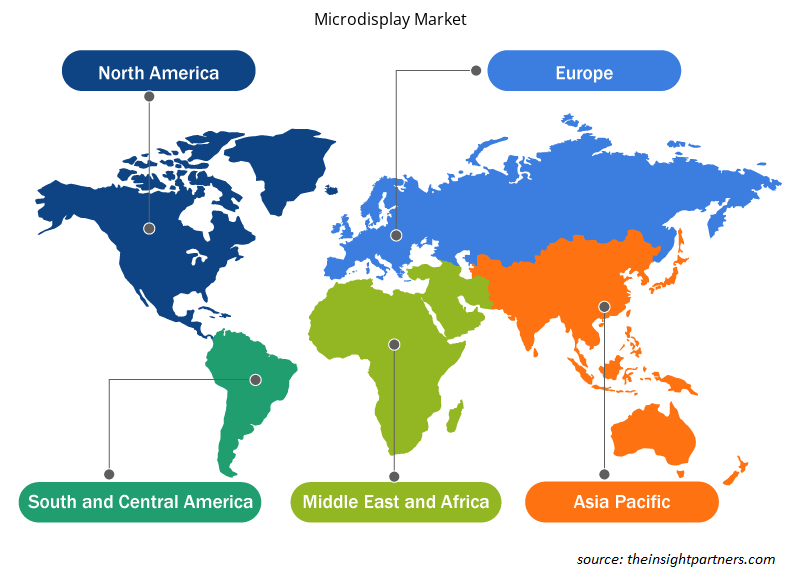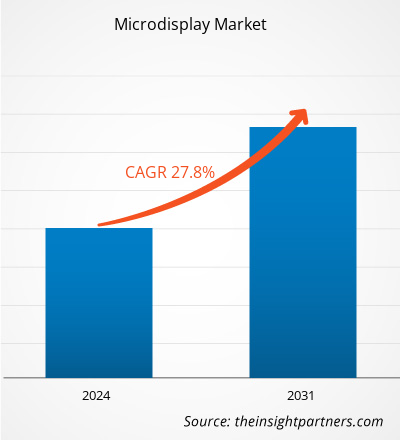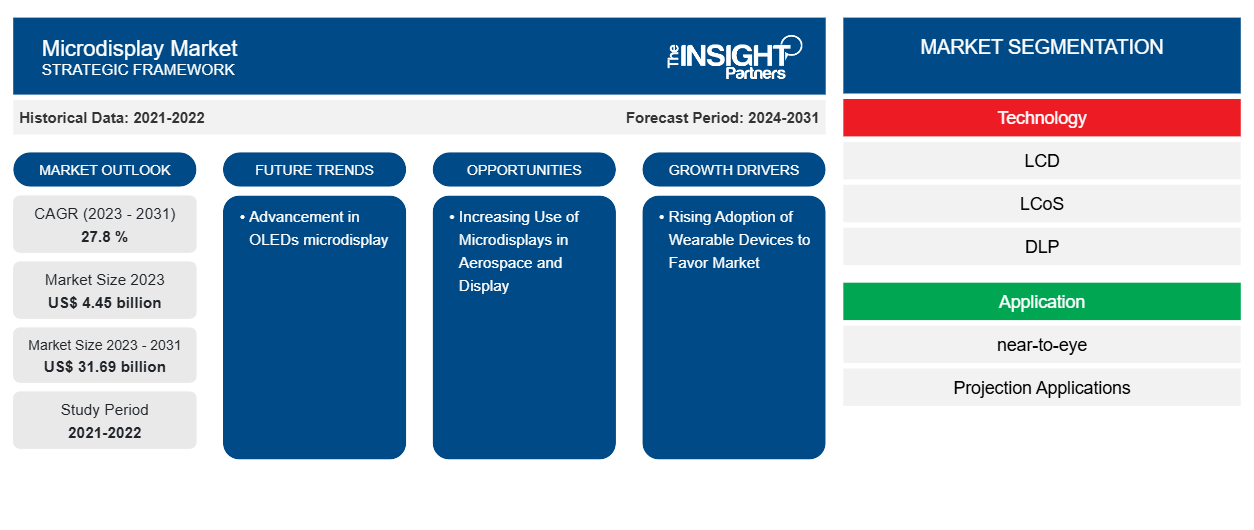Der Markt für Mikrodisplays soll von 4,45 Milliarden US-Dollar im Jahr 2023 auf 31,69 Milliarden US-Dollar im Jahr 2031 anwachsen. Der Markt soll zwischen 2023 und 2031 eine durchschnittliche jährliche Wachstumsrate (CAGR) von 27,8 % verzeichnen. Die zunehmende Verbreitung tragbarer Geräte sowie AR und VR dürften weiterhin wichtige Trends auf dem Markt für Mikrodisplays bleiben.
Mikrodisplay-Marktanalyse
Der Mikrodisplay-Markt wächst rasant, da Faktoren wie technologische Fortschritte, kompakte Größe und Miniaturisierung das Wachstum des Mikrodisplay-Marktes weiter beschleunigen. Darüber hinaus treibt auch die zunehmende Einführung hochauflösender Mikrodisplays (HMD) in verschiedenen Branchen das Marktwachstum voran.
Mikrodisplay-Marktübersicht
Ein Mikrodisplay ist ein kleiner oder miniaturisierter Bildschirm, der Anwendungen in kleinen Anzeigebereichen umfasst, darunter Digitalkameras, Smartphone-Bildschirme und mehr. Die steigende Nachfrage nach AR- und VR-Technologien treibt das Marktwachstum an. Darüber hinaus treibt auch die zunehmende Verbreitung tragbarer Geräte den Mikrodisplay-Markt an.
Passen Sie diesen Bericht Ihren Anforderungen an
Sie erhalten kostenlos individuelle Anpassungen an jedem Bericht, einschließlich Teilen dieses Berichts oder einer Analyse auf Länderebene, eines Excel-Datenpakets sowie tolle Angebote und Rabatte für Start-ups und Universitäten.
-
Holen Sie sich die wichtigsten Markttrends aus diesem Bericht.Dieses KOSTENLOSE Beispiel umfasst eine Datenanalyse von Markttrends bis hin zu Schätzungen und Prognosen.
Treiber und Chancen auf dem Mikrodisplay-Markt
Steigende Verbreitung tragbarer Geräte begünstigt den Markt
Die zunehmende Verbreitung tragbarer Geräte treibt das Wachstum des Mikrodisplay-Marktes voran. Mikrodisplays werden in großem Umfang in tragbaren Geräten wie Smartwatches, Fitnesstrackern, Smartphones usw. verwendet. Mikrodisplays bieten eine gute Bildqualität, einen geringen Stromverbrauch und die durch flexible OLEDs ermöglichten Designmöglichkeiten. Die meisten High-End-Smartwatches, Fitnessarmbänder und Headsets verwenden Mikrodisplays, darunter auch die Smartwatches von Apple und Samsung.
Zunehmender Einsatz von Mikrodisplays in der Luft- und Raumfahrt und Displayindustrie
Aufgrund kontinuierlicher Verbesserungen und der zunehmenden Verwendung von Mikrodisplays in Verteidigungs- und Luftfahrtanwendungen wird erwartet, dass der Mikrodisplay-Markt bald expandieren wird. OLED-Mikrodisplays mit geringem Stromverbrauch haben zahlreiche Verwendungsmöglichkeiten, darunter Zielfernrohre in der Luft- und Raumfahrt- und Verteidigungsindustrie, Wärmebildgeräte, Lageerkennungsgeräte und Nachtsichtbrillen. Der Einsatz hochentwickelter Mikrodisplays wird durch die wachsende Nachfrage der Branche nach hochwertigen HI-JDs und HMDs unterstützt.
Segmentierungsanalyse des Mikrodisplay-Marktberichts
Wichtige Segmente, die zur Ableitung der Mikrodisplay-Marktanalyse beigetragen haben, sind Technologie, Projektionsanwendungen und Branchenvertikalen.microdisplay market analysis are technology, projection applications, and industry verticals.
- Basierend auf der Technologie ist der Mikrodisplay-Markt in LCD, LCoS, DLP und OLED unterteilt.
- Nach Branchen ist der Markt in Militär und Verteidigung, Gesundheitswesen, Unterhaltungselektronik, Automobil, Strafverfolgung und andere segmentiert.
Mikrodisplay-Marktanteilsanalyse nach geografischer Lage
Der geografische Umfang des Mikrodisplay-Marktberichts ist hauptsächlich in fünf Regionen unterteilt: Nordamerika, Asien-Pazifik, Europa, Naher Osten und Afrika sowie Südamerika/Süd- und Mittelamerika. Nordamerika hat den Mikrodisplay-Markt dominiert. Trends zur Einführung hoher Technologien in verschiedenen Branchen in der nordamerikanischen Region haben das Wachstum des Mikrodisplay-Marktes vorangetrieben. Faktoren wie die zunehmende Einführung tragbarer Geräte und hohe Technologieausgaben von Regierungsbehörden werden voraussichtlich das Wachstum des nordamerikanischen Mikrodisplay-Marktes vorantreiben. Darüber hinaus zwingt eine starke Betonung von Forschung und Entwicklung in den entwickelten Volkswirtschaften der USA und Kanadas die nordamerikanischen Akteure dazu, technologisch fortschrittliche Lösungen auf den Markt zu bringen. Darüber hinaus gibt es in den USA viele Akteure auf dem Mikrodisplay-Markt, die sich zunehmend auf die Entwicklung innovativer Lösungen konzentrieren. All diese Faktoren tragen zum Wachstum des Mikrodisplay-Marktes in der Region bei.
Regionale Einblicke in den Mikrodisplay-Markt
Die regionalen Trends und Faktoren, die den Mikrodisplay-Markt im Prognosezeitraum beeinflussen, wurden von den Analysten von Insight Partners ausführlich erläutert. In diesem Abschnitt werden auch die Mikrodisplay-Marktsegmente und die Geografie in Nordamerika, Europa, im asiatisch-pazifischen Raum, im Nahen Osten und Afrika sowie in Süd- und Mittelamerika erörtert.

- Erhalten Sie regionale Daten zum Mikrodisplay-Markt
Umfang des Mikrodisplay-Marktberichts
| Berichtsattribut | Details |
|---|---|
| Marktgröße im Jahr 2023 | 4,45 Milliarden US-Dollar |
| Marktgröße bis 2031 | 31,69 Milliarden US-Dollar |
| Globale CAGR (2023 - 2031) | 27,8 % |
| Historische Daten | 2021-2022 |
| Prognosezeitraum | 2024–2031 |
| Abgedeckte Segmente |
Nach Technologie
|
| Abgedeckte Regionen und Länder |
Nordamerika
|
| Marktführer und wichtige Unternehmensprofile |
|
Dichte der Marktteilnehmer für Mikrodisplays: Deren Auswirkungen auf die Geschäftsdynamik
Der Markt für Mikrodisplays wächst rasant, angetrieben durch die steigende Nachfrage der Endnutzer aufgrund von Faktoren wie sich entwickelnden Verbraucherpräferenzen, technologischen Fortschritten und einem größeren Bewusstsein für die Vorteile des Produkts. Mit steigender Nachfrage erweitern Unternehmen ihr Angebot, entwickeln Innovationen, um die Bedürfnisse der Verbraucher zu erfüllen, und nutzen neue Trends, was das Marktwachstum weiter ankurbelt.
Die Marktteilnehmerdichte bezieht sich auf die Verteilung der Firmen oder Unternehmen, die in einem bestimmten Markt oder einer bestimmten Branche tätig sind. Sie gibt an, wie viele Wettbewerber (Marktteilnehmer) in einem bestimmten Marktraum im Verhältnis zu seiner Größe oder seinem gesamten Marktwert präsent sind.
Die wichtigsten auf dem Mikrodisplay-Markt tätigen Unternehmen sind:
- AUO Corporation
- eMagin.
- Himax Technologies, Inc.
- KOPIN Corporation
- LG Electronics.
- MicroVision
Haftungsausschluss : Die oben aufgeführten Unternehmen sind nicht in einer bestimmten Reihenfolge aufgeführt.

- Überblick über die wichtigsten Akteure auf dem Mikrodisplay-Markt
Neuigkeiten und aktuelle Entwicklungen zum Mikrodisplay-Markt
Der Mikrodisplay-Markt wird durch die Erhebung qualitativer und quantitativer Daten nach Primär- und Sekundärforschung bewertet, die wichtige Unternehmensveröffentlichungen, Verbandsdaten und Datenbanken umfasst. Im Folgenden finden Sie eine Liste der Entwicklungen auf dem Markt:
- Im Januar 2024 gaben die Kopin Corporation, einer der führenden Anbieter anwendungsspezifischer optischer Systeme und leistungsstarker Mikrodisplays für Verteidigungs-, Unternehmens-, Verbraucher- und Medizinprodukte, und MICLEDI Microdisplays eine strategische Vereinbarung zur Zusammenarbeit bei der Entwicklung und Herstellung fortschrittlicher Mikro-LED-Displays bekannt, um ein umfassenderes und informationsreicheres AR-Erlebnis für den Einsatz bei sehr hellen Lichtverhältnissen zu bieten.
(Quelle: Kopin Corporation, Pressemitteilung, 2024)
- Im März 2024 gab MICLEDI Microdisplays den ersten Abschluss seiner Finanzierungsrunde der Serie A mit Beteiligung von imec bekannt. Xpand, PMV, imec, KBC und SFPIM zeigten starke Unterstützung für das Wertversprechen des Unternehmens und die in der Seed-Runde erzielten kommerziellen und technologischen Fortschritte. Serie A folgt auf eine bedeutende Seed-Runde-Auszeichnung und zusätzliche nicht verwässernde Finanzierung in Form von Zuschüssen und anderen Mitteln von VLAIO. Damit beläuft sich die Gesamtfinanzierung des Unternehmens bisher auf fast 30 Millionen US-Dollar.
(Quelle: Aptean, Pressemitteilung, 2024)
Abdeckung und Ergebnisse des Mikrodisplay-Marktberichts
Der Bericht „Marktgröße und Prognose für Mikrodisplays (2021–2031)“ bietet eine detaillierte Analyse des Marktes, die die folgenden Bereiche abdeckt:
- Marktgröße und Prognose auf globaler, regionaler und Länderebene für alle abgedeckten wichtigen Marktsegmente.
- Marktdynamik wie Treiber, Beschränkungen und wichtige Chancen
- Wichtige Zukunftstrends
- Detaillierte PEST/Porters Five Forces- und SWOT-Analyse
- Globale und regionale Marktanalyse, die wichtige Markttrends, wichtige Akteure, Vorschriften und aktuelle Marktentwicklungen abdeckt.
- Branchenlandschaft und Wettbewerbsanalyse, einschließlich Marktkonzentration, Heatmap-Analyse, prominenten Akteuren und aktuellen Entwicklungen.
- Detaillierte Firmenprofile
- Historische Analyse (2 Jahre), Basisjahr, Prognose (7 Jahre) mit CAGR
- PEST- und SWOT-Analyse
- Marktgröße Wert/Volumen – Global, Regional, Land
- Branchen- und Wettbewerbslandschaft
- Excel-Datensatz
Aktuelle Berichte
Verwandte Berichte
Erfahrungsberichte
Grund zum Kauf
- Fundierte Entscheidungsfindung
- Marktdynamik verstehen
- Wettbewerbsanalyse
- Kundeneinblicke
- Marktprognosen
- Risikominimierung
- Strategische Planung
- Investitionsbegründung
- Identifizierung neuer Märkte
- Verbesserung von Marketingstrategien
- Steigerung der Betriebseffizienz
- Anpassung an regulatorische Trends























 Kostenlose Probe anfordern für - Mikrodisplay-Markt
Kostenlose Probe anfordern für - Mikrodisplay-Markt